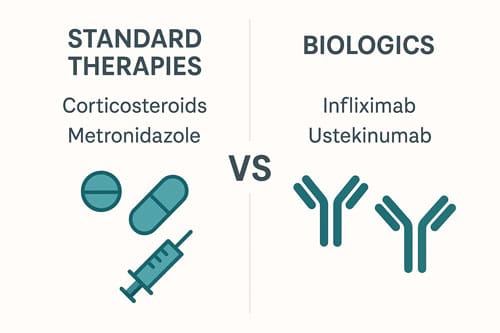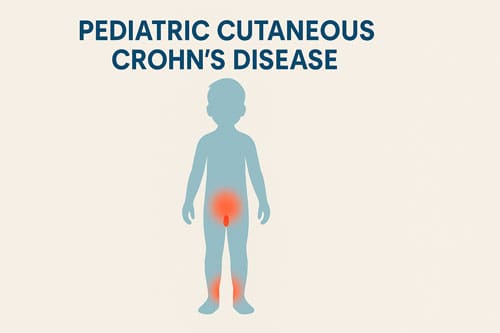(CCD) Cutaneous Crohn’s Disease Manifestations In The Pediatric Population
Overview
Cutaneous Crohn’s disease (CCD), also referred to as metastatic Crohn’s disease, is a rare but often underrecognized condition characterized by granulomatous inflammation affecting the skin. This study investigates the demographic, clinical, histological features, and treatment outcomes of 89 pediatric cases of CCD, including 11 newly identified cases from four academic centers and 78 previously reported cases. A particular focus is placed on the effectiveness of biologic monotherapy and dual biologic therapy.

A PubMed search was conducted using keywords related to CCD and metastatic Crohn’s disease. Patients were identified through a retrospective review of electronic health records, focusing on those with histopathologic diagnoses consistent with CCD. Data on demographics, clinical presentations, and treatment responses were extracted.
The majority of pediatric CCD patients are male (55%), with genital edema (82%) and erythema (53%) being the most common symptoms. A significant proportion (78%) also had concurrent intestinal Crohn disease. The most frequently prescribed medications were oral corticosteroids (71%) and metronidazole (39%). Tumor necrosis factor (TNF) inhibitors were highly effective, with 94% of treated patients experiencing partial or complete clearance of skin lesions. Ustekinumab was also beneficial, achieving complete clearance in 67% of treated cases and partial improvement in 33%. Two cases showed total resolution of skin lesions with dual biologic therapy, defined as the use of two biologics targeting different mechanisms or a combination of biologic therapy with a small molecule inhibitor.
TNF inhibitors appear to be a highly effective treatment option for pediatric CCD. Additionally, interleukin-12/23 inhibitors show promise, and dual biologic therapy may offer significant benefits for patients requiring treatments that address both intestinal and cutaneous manifestations of Crohn disease.
Introduction
Crohn’s disease (CD) is a chronic inflammatory disorder characterized by granulomatous inflammation that can affect any part of the gastrointestinal (GI) tract, ranging from the mouth to the anus. While it is primarily known for its GI involvement, CD can present with a wide range of extraintestinal manifestations. Up to 19% of individuals with intestinal Crohn’s disease also experience cutaneous manifestations, making skin involvement a notable aspect of the disease. Among these, Cutaneous Crohn’s disease (CCD) is the least commonly recognized but potentially underreported due to its variable and sometimes subtle clinical presentations.
CCD is defined by the presence of granulomatous inflammation in the skin, occurring either without direct extension from the GI tract or in patients without any intestinal involvement at all. This distinction makes CCD a unique and challenging condition to diagnose, as it can mimic other dermatologic disorders and may be missed in the absence of GI symptoms. Its true prevalence could be higher than currently reported, as the clinical spectrum of CCD can range from mild, localized lesions to more severe and widespread skin involvement.
In this comprehensive review, we examine 89 pediatric cases of CCD, combining 78 previously published cases with 11 newly reported patients. This offers an extensive overview of CCD in children, a population that presents distinct challenges in diagnosis and management. Additionally, we describe two cases of pediatric patients who were treated with dual biologic therapy, providing insight into emerging treatment strategies for more complex cases of CCD.
The review also sheds light on the epidemiology of pediatric CCD, noting potential patterns and risk factors. Clinical presentations of CCD in children can vary widely, from skin nodules and plaques to more extensive ulcerative lesions, highlighting the importance of early recognition and differentiation from other skin conditions. Histopathological examination typically reveals non-caseating granulomas, a hallmark of Crohn’s disease, but the appearance can vary based on the lesion’s stage and severity.
In terms of treatment, the management of CCD often involves a combination of therapies, ranging from topical and systemic medications to advanced biologic agents. Corticosteroids and immunosuppressants have historically been the mainstay of treatment; however, the advent of biologic therapies, such as TNF inhibitors and integrin blockers, has revolutionized the management of CD and its cutaneous manifestations. In cases of pediatric CCD, biologic therapy is increasingly recognized as a valuable option, particularly for patients with severe or refractory disease. The discussion of two pediatric patients receiving dual biologic therapy emphasizes the evolving landscape of treatment options and the potential for personalized therapeutic approaches in complex cases.
This review provides a detailed update on the clinical, histopathological, and therapeutic aspects of pediatric CCD, emphasizing the critical role of biologic therapies in the management of this challenging condition. The findings highlight the importance of recognizing CCD as part of the broader spectrum of Crohn’s disease and underscore the need for continued research into its pathophysiology and treatment.
Methods
A PubMed search identified 78 documented cases of pediatric cutaneous Crohn’s disease (CCD), all published in English or translated, spanning from 1970 to June 2022. The search utilized terms such as “metastatic Crohn disease,” “cutaneous Crohn disease,” “vulvar granulomatosis,” “vulvitis granulomatosa,” “anogenital granulomatosis,” “penile Crohn disease,” and “granulomatous lymphangitis.” Only cases with confirmed diagnoses through skin or intestinal biopsies, paired with dermatologically validated skin findings, were included. Additionally, histology-confirmed cases were sourced from a multicenter retrospective registry at the University of Wisconsin, under IRB approval. Data on patient demographics, intestinal disease status, cutaneous presentation, histology, and treatments were collected.

Treatment outcomes were categorized into four groups: “clearance,” “partial clearance,” “no effect,” or “worsening.” Treatments were documented in chronological order, with some administered concurrently. Due to varying consistency in symptom resolution reporting, outcomes were assessed based on the patient’s status at the time of the last available report or follow-up. “Clearance” referred to the complete resolution of skin symptoms and visible lesions, while “partial clearance” indicated improvement without full resolution. “No effect” implied no change in symptoms, and “worsening” referred to increased symptom severity, such as greater pain, larger or more numerous lesions, or the spread of lesions to other body areas.
Result
The cohort study includes 89 pediatric cases of cutaneous Crohn’s disease (CCD), comprised of 78 previously documented cases and 11 newly identified from a registry. Of these, 55% were boys and 45% were girls. The average age of diagnosis was 10.4 years for boys and 11.2 years for girls. The genitals were the most commonly affected area, involving 75% of cases. Specifically, 85% of girls had vulvar involvement, while 67% of boys had penile and/or scrotal involvement. Boys were also more likely to experience facial involvement (33% of boys versus 10% of girls).
Clinical features included edema (82%), erythema (53%), perianal skin tags (31%), induration (21%), and less frequent manifestations like fissures, ulcerations, lymphedema, abscesses, papules, nodules, fistulae, and erosions. Additionally, 78% of patients were found to have intestinal Crohn’s disease (CD), though this was influenced by varying follow-up durations. Among the 11 registry cases, six had intestinal CD, with one being diagnosed within 12 months of CCD diagnosis, while others had preexisting CD or were followed without developing intestinal CD.
Histologically, noncaseating granulomas were found in 90% of biopsies, while 5% showed caseating granulomas. Multinucleated giant cells were identified in 33% of cases, and perivasculitis was seen in 13%. Eosinophils were rarely observed, reported in just 5% of biopsies.
Regarding treatment, outcomes were reported in 75 cases. Total clearance was achieved in 39% of patients, while 48% had partial clearance. Corticosteroids were the most frequently used systemic treatment, utilized in 71% of cases, followed by oral metronidazole in 39%. Biologic agents, particularly TNF-alpha inhibitors, were employed in 21% of cases, with infliximab being the most commonly used. Remarkably, 94% of patients treated with TNF blockers experienced partial or total clearance. Other biologic agents, like ustekinumab, showed efficacy in some cases.
In two instances, remission of both intestinal and cutaneous disease was achieved with dual biologic therapy. One case involved a 13-year-old boy whose cutaneous disease resolved with ustekinumab, while his gastrointestinal symptoms improved after combining ustekinumab with vedolizumab. Another case involved a 12-year-old girl with both CCD and intestinal CD. While ustekinumab alone was ineffective, a combination of biologics ultimately resulted in remission of both cutaneous and intestinal disease.
Conclusion
Cutaneous Crohn’s disease (CCD) affects individuals across all age groups, though its true incidence remains uncertain due to its variable presentation, leading to misdiagnosis and delays in diagnosis. Diagnosis is particularly delayed in children as CCD often manifests in the genital region, which can resemble sexual abuse or post-traumatic lymphedema. Pediatric cases of CCD show different epidemiology compared to adults. For example, boys are more frequently affected in pediatric cases, contrasting with adults, where 64% of cases are female. The average age for pediatric diagnosis is around 11 years, but there is no clearly established age of diagnosis for adults.
The clinical presentation of CCD is typically divided into genital and nongenital manifestations. Nongenital CCD can present as nodules, plaques, ulcers, fissures, or papules, while genital CCD typically manifests as erythema, edema, and ulcerations in the anogenital area. The most frequently affected areas are the genitals, lower extremities, and face. CCD can be easily mistaken for other conditions like hidradenitis suppurativa, cellulitis, or sexually transmitted infections, complicating diagnosis. A thorough clinical history, physical exam, and biopsy can help differentiate CCD from other conditions. Importantly, CCD can precede or be diagnosed concurrently with intestinal Crohn’s disease (CD), especially in children, with many pediatric cases diagnosed with intestinal CD within six years of the CCD diagnosis.
Histopathological findings in CCD often reveal noncaseating granulomas, histiocytes, and giant cells, although findings can vary. While biopsy can assist in confirming CCD, it may not always be necessary, particularly in children due to the prevalence of genital involvement.
Treatment strategies for CCD lack consensus, and no single therapy has demonstrated consistent efficacy. First-line therapies generally include topical, intralesional, or systemic steroids, with other options such as calcineurin inhibitors for facial lesions and metronidazole for more severe cases. Immunosuppressive drugs like cyclosporine, methotrexate, and TNF blockers are also considered. The role of biologic therapies, particularly TNF blockade and IL-12/23 inhibitors, has shown promise in treating pediatric CCD. Despite the limited number of cases and varying responses to treatment, combining these biologic therapies may improve outcomes in both pediatric and adult CCD, especially in patients with coexisting intestinal and cutaneous disease. This is based on the largest pediatric CCD review, encompassing 89 cases, which highlights the potential efficacy of these treatment approaches.

